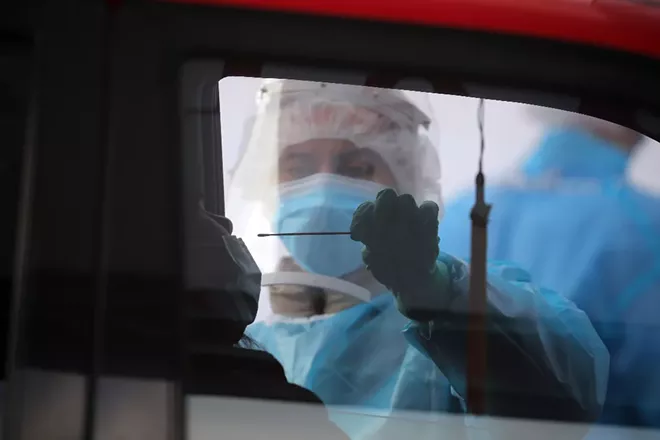
Jim Wilson/The New York Times
A driver is tested for coronavirus infection at a site in Oakland, Calif., Nov. 19, 2020. People with Covid-19, the illness caused by the coronavirus, are most infectious about two days before symptoms begin and for five days afterward, according to a new analysis of previous research.
The New York Times
People with COVID-19, the illness caused by the coronavirus, are most infectious about two days before symptoms begin and for five days afterward, according to a new analysis of previous research.
A few patients who are extremely ill or have impaired immune systems may expel — or “shed” — the virus for as long as 20 days, other studies have suggested. Even in mild cases, some patients may shed live virus for about a week, the new analysis found.
The accumulating data presents a quandary: Should public health officials shorten the recommended isolation time if it means more infected people will cooperate? Or should officials opt for longer periods in order to prevent transmission in virtually all cases, even if doing so takes a harsher toll on the economy?
The Centers for Disease Control and Prevention recommends that infected people isolate for a minimum of 10 days from the beginning of their illness. The agency is considering shortening the recommended isolation period and may issue new guidelines as early as next week, according to two federal officials with knowledge of the discussions.
In September, France dropped its required period of isolation to seven days from 14 days, and Germany is considering shortening it to five days. (Isolation refers to people who are ill; quarantine refers to people who have been exposed to the virus and may become ill.)
Setting the isolation period at five days is likely to be much more palatable and may encourage more infected people to comply, said Dr. Muge Cevik, an infectious disease expert at the University of St Andrews in Scotland who led the new analysis, published in the journal The Lancet Microbe.
A recent survey in the United Kingdom showed that only 1 in 5 people were able to isolate for 10 days after developing symptoms. “Even if we do more testing, if we can’t ensure people self-isolate, I don’t think we’ll be able to control the spread,” Cevik said.
In the United States, many people don’t get tested for the infection until a day or two after they begin to feel ill. With the current delays, many receive results two or three days later, toward the end of the period during which they are infectious.
